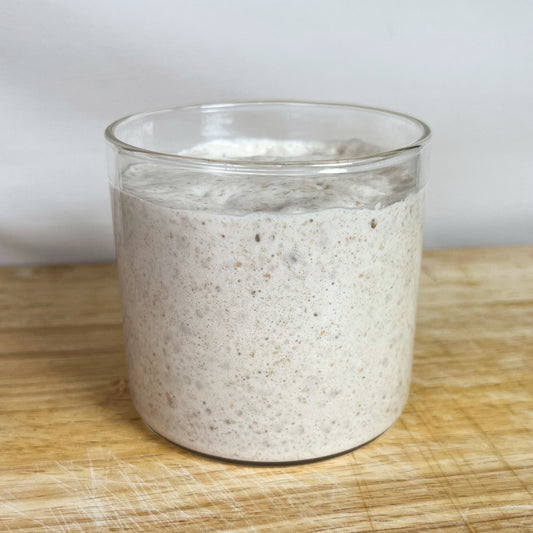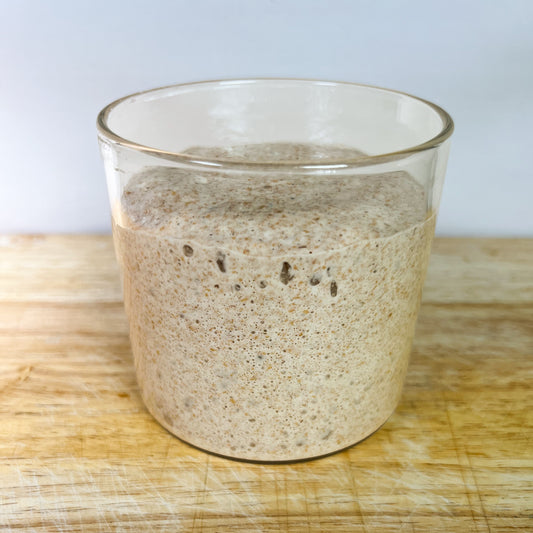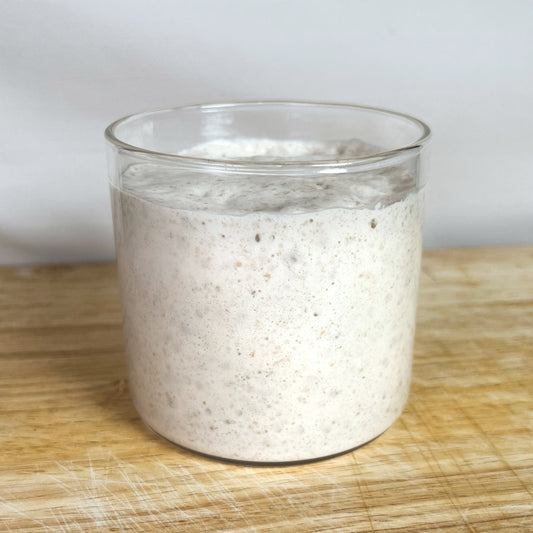5 Creative Ways to Use a Dough Scraper in Your Baking

When it comes to baking, having the right tools is essential. Among those tools, few are as versatile and useful as the dough scraper. In this article, we'll explore five creative ways to use a dough scraper in your baking, from shaping and scoring bread to achieving consistent sizes for your pastries, and more. So, let's dive in and discover what this tool can do for your baking.
Understanding the Versatility of a Dough Scraper
A dough scraper is a versatile and inexpensive tool used in both commercial and home baking. Its primary function is to help manage the dough while also saving time and effort. But, beyond that, it can be used for many purposes, making it a valuable addition to any baking toolkit.
The Basics of a Dough Scraper
A dough scraper is a flat piece of metal, plastic, or wood with a straight edge that is used to cut, divide, and lift dough. It comes in various sizes and shapes, from small handheld scrapers to larger bench scrapers. Kitchen supply stores offer many options, so there's a scraper out there to fit every need and budget.
One of the primary functions of a dough scraper is to help manage the dough while it's being worked. When making bread or other dough-based recipes, the dough can be sticky and difficult to handle. A scraper can be used to lift the dough off of surfaces, such as countertops or cutting boards, without damaging the dough or leaving any residue behind. This makes it easier to work with the dough and saves time and effort in the process.
Another use for a dough scraper is to divide the dough into equal portions. This is especially useful when making recipes that require uniform portions, such as dinner rolls or pizza dough. By using a scraper to cut the dough, you can ensure that each portion is the same size, which will help the finished product to cook evenly.
Buy our Metal Bench Scraper or Plastic Bowl Dough Scraper here.
Choosing the Right Dough Scraper for Your Needs
When choosing a dough scraper, consider the size and shape of the scraper, as well as the material it is made from. Most importantly, choose a scraper that feels comfortable in your hand and meets your specific baking needs. If you work with small batches of dough, a small scraper may suffice, while larger batches may require a larger scraper.
Additionally, consider the material the scraper is made from. Plastic scrapers are the most affordable option and are easy to clean, but they may not be as durable as metal or wood scrapers. Metal scrapers are sturdy and can handle heavy use, but they can be more expensive. Wood scrapers are a great option for those who prefer a more traditional look and feel, but they may require more maintenance to keep them in good condition.
In conclusion, a dough scraper is a versatile tool that can make baking easier and more efficient. Whether you're a professional baker or a home cook, adding a dough scraper to your toolkit is a smart choice that will pay off in the long run.
Technique 1: Perfectly Shaped Scones and Biscuits
One of the essential functions of a dough scraper is cutting and shaping the dough. Whether you're making scones or biscuits, a dough scraper can help you achieve consistent sizes and shapes.
But did you know that the shape of your scones or biscuits can affect the way they taste? It's true! A perfectly shaped scone or biscuit can make all the difference in the world.
When you use a dough scraper to cut and shape your dough, you can ensure that each scone or biscuit is the same size and shape. This means that they will cook evenly and have a consistent texture throughout.
How to Cut and Shape Dough with a Scraper
For scones and biscuits, roll out the dough, and cut it into uniform rounds or squares. Using a dough scraper, gently pick up each piece and place it on a baking sheet. Not only will this give your baked goods a polished look, but it will also make sure that they cook evenly.
But what if you want to get creative with your shapes? No problem! A dough scraper can also help you create unique shapes and designs for your scones and biscuits. Simply use the scraper to cut the dough into the desired shape, and voila! You have a one-of-a-kind treat.
Tips for Achieving Consistent Sizes
To ensure that your scones or biscuits are all evenly sized, use a ruler or a measuring cup to get the exact size you want before using the scraper to cut the dough. This will help ensure even cooking and equally sized treats.
Another tip for achieving consistent sizes is to use the same amount of dough for each scone or biscuit. This can be done by using a cookie scoop or a kitchen scale to measure out the dough.
With these tips and techniques, you'll be able to create perfectly shaped scones and biscuits every time. Your family and friends will be impressed with your baking skills, and you'll enjoy delicious treats that look as good as they taste!
Technique 2: Creating Artisan Bread Designs
Do you enjoy creating visually stunning bread? A dough scraper can help you achieve beautiful and intricate bread designs. But how exactly does it work?
First, it's important to understand the science behind bread baking. When bread is in the oven, it expands as the yeast produces carbon dioxide gas. However, if the surface of the bread is too smooth, it can prevent the bread from expanding evenly, resulting in a dense and unappetising loaf. We typically recommend you do this with a bread lame but you can achieve scoring with a dough scraper.
Read more: Bread Lames vs. Other Scoring Tools: Pros and Cons
This is where a dough scraper comes in. By creating scores or cuts on the surface of the dough, the bread is able to expand more uniformly during baking, resulting in a lighter and fluffier loaf. But scoring your bread isn't just about function - it can also add a beautiful aesthetic appeal to your finished product.
Scoring Dough for Beautiful Patterns
To score bread, gently press the blade of the scraper into the surface of the dough. You can create straight lines, intricate designs, or even letters or shapes. The possibilities are endless! However, it's important to note that the depth of the score can affect the final outcome. A shallow score will create a more subtle design, while a deeper score will create a more pronounced design.
One popular scoring technique is the "ear," which is created by making a diagonal cut on the surface of the dough. This cut allows the bread to expand and creates a beautiful, rustic look.
Enhancing Your Bread's Aesthetic Appeal
For a more rustic, artisan appearance, dust the loaf with flour before baking. This will create stark and contrasting lines that are sure to impress both your eyes and your taste buds. You can also experiment with different types of flour, such as rye or cornmeal, to create unique and interesting designs.
Remember, scoring your bread is not only functional, but it's also an opportunity to express your creativity and make your bread truly unique. So go ahead, grab your dough scraper, and let your imagination run wild!
Technique 3: Efficiently Folding and Shaping Dough
Working with dough can be messy and time-consuming, but a scraper can help speed up the process while also reducing mess. However, there are a few other tips and tricks that can make the process even smoother.
Mastering the Art of Dough Folding
For foldable dough, like croissant or puff pastry, a scraper can help you perform this task by gently lifting the dough and folding it over. This helps create the flaky layers that everyone craves in goodies like these. However, it's important to note that the temperature of the dough is also a crucial factor. If the dough is too warm, it can become difficult to work with and may not hold its shape. To avoid this, try chilling the dough for a few minutes before folding it with the scraper.
Another important aspect of dough folding is the number of folds. While it may be tempting to keep folding the dough to create even more layers, it's important to know when to stop. Over-folding the dough can cause it to become tough and lose its flaky texture. As a general rule, aim for no more than six folds for croissant or puff pastry dough.
Shaping Dough for Various Baked Goods
A dough scraper can also help you shape and form the dough into more complex shapes. For example, if you're making a brioche or any other dough that requires intricate shaping, use the scraper to help you get the desired shape without tearing or damaging the dough. However, keep in mind that the type of flour used can also affect the dough's ability to hold its shape. Bread flour, for example, has a higher protein content and can create a more structured dough.
When shaping dough, it's also important to consider the final product. For example, if you're making bread, you may want to shape the dough into a round loaf or a baguette. However, if you're making pastry, you may want to shape the dough into individual portions, like croissants or turnovers. The dough scraper can help you achieve these shapes with precision and ease.
In conclusion, while a dough scraper is a valuable tool to have in your baking arsenal, it's important to also consider other factors when working with dough. By mastering the art of dough folding and shaping, and paying attention to temperature and flour type, you can create delicious baked goods with ease.
Technique 4: Quick and Easy Cleanup
Baking is a therapeutic activity that can be enjoyed by anyone. However, the aftermath of baking can be overwhelming, especially when it comes to cleaning up the mess. But don't let that discourage you. With the right tools and techniques, cleaning up can be quick and easy.
One such tool is the dough scraper. This versatile tool can be used for more than just scraping dough.
Scraping Excess Dough from Surfaces
As mentioned, the dough scraper can be used to scrape off any excess dough or flour from your surfaces. This is especially useful when working with sticky dough that tends to cling to surfaces. By using the scraper, you can easily remove any excess dough or flour, saving you time and making cleanup a breeze.
But that's not all. The scraper can also be used to divide dough into portions, and to lift and move dough from one place to another.
Cleaning Your Dough Scraper Properly
Now that you know how useful a dough scraper can be, it's important to know how to clean it properly. Cleaning your dough scraper is easy. Simply wash it with soap and water, then dry it off. Some scrapers are dishwasher-safe, but check the manufacturer's instructions before washing it this way.
It's important to clean your dough scraper after each use to prevent any buildup of dough or flour. This will not only keep your scraper in good condition, but it will also ensure that your baked goods are free from any unwanted debris.
So don't let the fear of cleanup deter you from enjoying the joys of baking. With the right tools and techniques, cleanup can be quick and easy, leaving you with more time to savor the delicious treats you've created.




